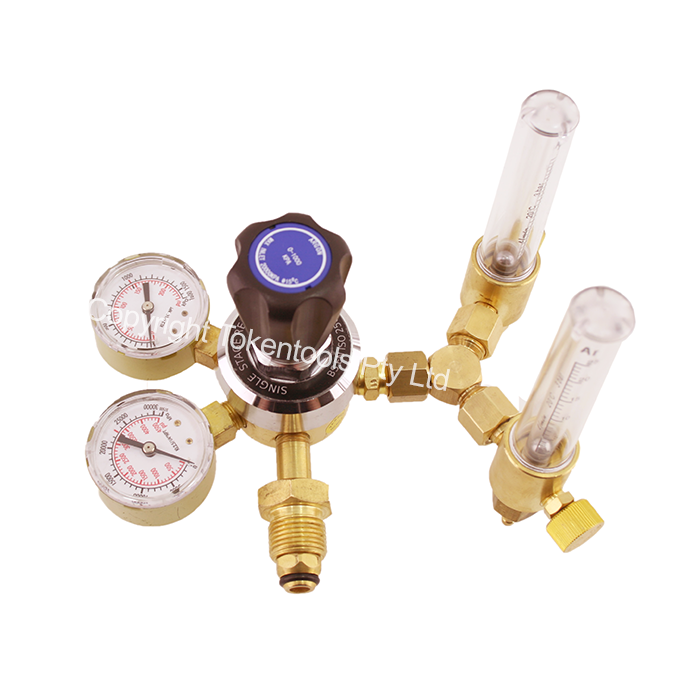Thanks Weldmonger and Ace much appreciated for the comprehensive feedback.
Yes, pretty obvious for the best way forward as you say.
I got a number of interesting responses from a local reputable exhaust system shop and a supplier of exhaust piping who worked on performance vehicles for years. Basically, they gave me the impression that a lot of shops don't back purge at all. Quote "you're over thinking it". I don't mind over thinking it as it is the journey and the learning that makes it more fun.
Ah the DIY solution - love it: I was thinking of the poor man's purge kit as explained well on The Fabrication Series:
https://www.youtube.com/watch?v=d8vN4vwX4ag cheap and easy to add to my existing rig.
I'm also trying to find out if my Weldclass Platinum series regulator will support two flow meters (two low pressure outlets) but the regulator plugged outlets are not labelled.
https://www.weldclass.com.au/product-gr ... regulators. No luck from the retailer or other outlets, so I am now waiting on the manufacturer for a response. That would be a neater solution though more expensive. I'm probably over thinking this bit

Initially I thought the solar B flux would be a more manageable solution but I got turned off when the documentation said it shouldn't be used on 309 (not sure if that also meant with 309 filler rod), and the application of the flux tricky and messy and might not be worth the extra effort compared to the DIY purge solution - gas cost aside. I confirmed the 309 constraint with the manufacturer, though I think the response was more generic and best practice. Its great how so many companies are willing to respond promptly to individuals. The poor man's purge kit might result in a better result and work for the remainder of aluminium welding I need to do. Plus your suggestions above combined should do the trick.
My main interest is nutting out the importance of using 308L over 309L for welding 304 stainless exhaust for a turbo vehicle:
- I have 2kg of 309LSI that will last me a life time and I found it great to work with on my first task. So why not use it for the exhaust?
- I could buy some 308L and have two life times of filler rod in stock

and I'd be using what is recommended by just about everybody (one welder said, just keep 316 and use it, which is what my very first supplier gave me for the 304 flange welding - it was problematic with the mixed metals - of course).
- the 309L would support 304 to 409 welds (e.g. cat converter might be 409) and 304 to mild steel (e.g. welding up to my old mild steel rear section exhaust as an interim solution - which has not rusted after 26 years)
- my first few welds on the vehicle were actually done with 316L filler rod. I successfully welded a few nuts (mild steel, 304 and 316) to junk panel metal, and other mystery plated metal (yellowish coating). I tested the same with the 309 and it was like chalk and cheese.
This is from
https://www.lincolnelectric.com/en-gb/s ... etail.aspx
When should I use 308L, 309L or 316L filler metal?
308L (including ER308LSi) is predominately used on austenitic stainless steels, such as types 301, 302, 304, 305 and cast alloys CF-8 and CF-3. For high temperature applications such as in the electrical power industry, the high carbon 308H electrode provides better creep resistance than does 308L.
316L (including ER316LSi) filler metal should be used with 316L and 316 base metals. CF-8M and CF-3M are the cast equivalents of 316 and 316L, respectively.
Use 309L (including ER309LSi) when joining mild steel or low alloy steel to stainless steels, for joining dissimilar stainless steels such as 409 to itself or to 304L stainless, as well as for joining 309 base metal. CG-12 is the cast equivalent of 309. Some 308L applications may be substituted with 309L filler metal, but 316L or 316 applications generally require molybdenum and 309L contains no molybdenum.
Now this might stir the pot or incite a laugh but the great information that caught my eye on the AWS forum titled "308 vs 309" got me to thinking that 309L would actually be better to use in my case as the 309 provided marginally better high temperature strength, ductility, and less chance of hot cracking:
The 2 main advantages of using a 309 instead of a 308 when joining a stainless steel to another steel is 1) the higher chemistry, Cr=22.0-25.0 and Ni=12.0-14.0 for the 309, as opposed to Cr=18.0-21.0 and Ni=9.0-11.0 for the 308. And 2) the 309 has a higher ferrite percentage than the 308. A typical 309 can have a FN of approximately 12-18 FN, while the 308 is usually approximately 4-9 FN. Ferrite is beneficial in counteracting the possibility of hot cracking, or solidification cracking. Both the 308 and the 309 have an All-Weld-Metal Tensile requirement of 80ksi minimum"
and additional clarification
...the higher chromium content in 309 promotes the formation of ferrite and increases resistance to oxidation and corrosion. The higher nickel content in 309 promotes the formation of austenite, and increases high temperature strength, corrosion resistance, and ductility.
So with all that info above, it begs the question: can 309 be used instead of 308 for producing a good strong weld of 304 stainless exhaust pipe? or what important piece of chemistry or mechanical disadvantages/advantages have I missed?



